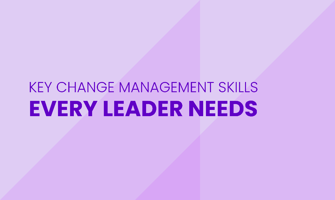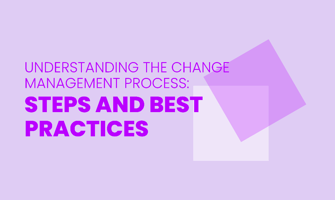Leaders are responsible for setting the tone, cultivating a culture that embraces change, and...
Comprehensive Change Management Training: Techniques and Benefits
Change management training is essential for organizations to handle transitions smoothly and effectively. It equips professionals with the skills necessary to lead their teams through changes and achieve successful outcomes.
This article explores the key components and benefits of change management training, demonstrating how it prepares leaders to manage resistance, engage stakeholders, and ensure that changes are smoothly integrated and sustained within their organizations.
For further information on Change Management, read What is Change Management? An Introductory Guide
Why Change Management Training Matters
Change management involves guiding and implementing organizational change to achieve desired outcomes. Change management training equips leaders and managers with the skills needed to anticipate, prepare for, and facilitate change within an organization.
Change management training helps leaders identify potential resistance and address it proactively. Providing adequate training for employees to help them master new ways of doing things can significantly improve the success rate of change initiatives. In fact, organizations that invest in proper training boost the probability of change initiative success by 12%. Understanding change management principles ensures that change initiatives are handled strategically, fostering an agile and resilient corporate culture.
Enhanced Productivity and Engagement: A well-trained team can boost productivity, increase employee engagement, and sustain momentum for change.
Comprehensive Understanding: Training ensures that change initiatives are fully understood and embraced at all organizational levels.
Effective Leadership: Transforming managers into effective change leaders is a core benefit of change management training.
Mastering change management prepares personnel for immediate challenges and the long-term evolution of the business landscape.
![]()
Key Components of Change Management Training
1. Understand Change Management Principles and Theories
Change management is a systematic approach to transitioning or transforming an organization's goals, core values, processes, or technologies.
Key theories include:
Lewin's Change Management Model: Involves unfreezing, changing, and refreezing to ensure lasting change.
Kotter's 8-Step Change Model: Provides a step-by-step approach to implementing change, emphasizing the importance of creating a sense of urgency and building a strong coalition.
Benefits
Effective Facilitation: Identifies actions to facilitate effective change.
Inspiring Change: Equips individuals to implement and inspire change.
Organizational Alignment: Ensures that change initiatives resonate at all organizational levels
Techniques to Implement Change Management Principles and Theories
Build a Strong Educational Foundation: Participate in courses and earn certifications in change management, organizational development, and project management. These provide a thorough understanding of key concepts and theories.
Develop Tailored Change Strategies: Use knowledge from educational resources to create change strategies specific to your organization. Tips for this include conducting a thorough needs assessment, involving key stakeholders in the planning process, and setting clear, measurable goals.
Engage Stakeholders: Communicate the change vision and plan with all stakeholders using effective tools and techniques. Tools like 180ops provide comprehensive solutions for managing and integrating data efficiently, enhancing transparency, communication, and actionable insights across the team. Utilize collaboration platforms for transparent communication, project management software to track progress, and regular meetings to ensure alignment and address concerns.
Monitor and Adjust: Follow the steps outlined in the roadmap, monitor progress with data analytics tools, and adjust strategies as needed. Ensure successful implementation and solidification of changes by reinforcing new behaviors and processes.
2. Develop Leadership and Communication Skills
Bringing about positive change within an organization heavily relies on the ability of its leaders to communicate effectively and lead by example.
Comprehensive change management training focuses on developing specific leadership and communication skills, like clearly explaining the change goals, engaging stakeholders, and actively listening to team members, equipping leaders with the necessary tools to influence and drive change initiatives successfully.
Benefits
Articulate Vision: Leaders proficient in communication can clearly explain the change goals, ensuring everyone understands what needs to be achieved.
Generate Buy-In: Buy-in means getting support from team members. Effective leadership fosters buy-in, increasing support for change initiatives.
Foster Transparency and Trust: Strong communication skills create an environment of transparency and trust, which is crucial for successful change.
Techniques to Implement Leadership and Communication Skills
Engage in Change Management Training: Participate in modules on collaborative leadership, which include interactive activities such as group exercises and simulations that mimic real-world scenarios. These activities help leaders practice and improve their leadership and communication skills in a controlled environment.
Utilize Case Studies and Role-Playing: Use practical exercises like case studies and role-playing to strengthen leadership actions and foster employee engagement. For example, analyzing successful change management case studies or role-playing difficult conversations can provide hands-on experience.
Implement Effective Feedback Loops: Regularly provide and receive feedback using techniques like anonymous surveys and tools like feedback software. This helps to continuously improve communication and leadership practices.
Use Communication Tools and Active Listening: Implement project management software to enhance collaboration and ensure consistent messaging across the team. Encourage leaders to practice active listening techniques, such as paraphrasing and asking clarifying questions, to better understand team concerns and suggestions.
![]()
3. Engage and Analyze Stakeholders
Stakeholder analysis involves identifying and understanding the concerns and interests of those affected by the change. This process is fundamental to tailoring communication and involvement strategies effectively.
Benefits
Increase Support: Effective stakeholder engagement can lead to increased support for change initiatives and diminished resistance.
Gain Vital Perspectives: Engaging stakeholders brings important perspectives to the planning process, ensuring diverse voices within the organization help shape the change.
Techniques to Implement Stakeholder Engagement
Identify Stakeholders: Identify all individuals and groups affected by the change. Use stakeholder mapping tools to visualize their influence and interest levels.
Conduct Stakeholder Analysis: Assess stakeholders' concerns, interests, and potential impact on the change process. Techniques like interviews, surveys, and focus groups can be useful.
Craft a Strategic Communication Plan: Develop a communication plan that addresses stakeholders' specific concerns and keeps them informed throughout the change process. Utilize project management software and collaboration platforms to facilitate clear and consistent communication.
Implement High-Involvement Approach: Actively involve stakeholders in the change process. This can include regular update meetings, feedback sessions, and workshops to ensure their input is considered and valued.
4. Assess Readiness and Impact
Assessing an organization's readiness for change and evaluating the potential impact of new initiatives are essential components that shape the trajectory of a change management strategy.
Readiness refers to the organization's preparedness to implement and sustain changes, including factors like resources, stakeholder support, and existing capabilities.
These assessments help identify potential obstacles and readiness gaps, allowing for proactive measures to address them. Also, understanding the impact ensures that the change is sustainable and aligned with organizational goals.
Benefits
Ensure Preparedness: Conducting a thorough assessment ensures the organization is prepared to accept change.
Smooth Integration: Helps integrate change into existing processes without disrupting workflow.
Guide Targeted Interventions: Aids in creating a gap statement that guides the development of targeted interventions.
Techniques to Implement Readiness and Impact Assessment
Utilize SWOT Analysis: Conduct a SWOT (Strengths, Weaknesses, Opportunities, Threats) analysis by gathering a diverse group of stakeholders to evaluate internal strengths and weaknesses, and external opportunities and threats. This helps identify factors that can impact the change process and inform strategic planning.
Conduct Readiness Workshops: Organize workshops with key stakeholders such as department heads, project managers, and team leaders. Discuss specific topics such as current readiness levels, potential barriers, required resources, and strategies for engagement and support. These discussions help build a comprehensive understanding of the organization's readiness for change.
Implement Risk Assessment Tools: Use risk assessment tools like risk matrices to identify, analyze, and prioritize risks associated with the change. Document potential risks, evaluate their likelihood and impact, and develop mitigation strategies to address high-priority risks.
Leverage Change Readiness Models: Apply the ADKAR model (Awareness, Desire, Knowledge, Ability, Reinforcement) to assess and enhance readiness. The ADKAR model involves ensuring stakeholders are aware of the need for change, fostering a desire to support the change, providing the necessary knowledge and training, developing the skills and abilities required to implement the change, and reinforcing the change to sustain it. Conduct surveys and interviews to assess each stage of the ADKAR model, and use the results to develop targeted interventions that address gaps in readiness.
5. Create and Implement Change Plans
A change plan outlines the steps necessary to achieve desired outcomes and serves as a roadmap for the change journey. It includes detailed actions, timelines, and resources needed to guide the organization through the change process.
![]()
Benefits
Actionable Steps and Clear Milestones: A well-crafted change plan lays the groundwork for actionable steps and clear milestones.
Improved Coordination: Enhances coordination among teams, ensuring everyone works towards common objectives.
Structured Timetable: Provides a structured timetable for implementation, facilitating clear communication of objectives and timelines.
Techniques to Implement Change Plans
Utilize Change Management Frameworks: Apply established change management frameworks to guide the creation of your change plan. Frameworks such as Kotter’s 8-Step Change Model or Lewin’s Change Management Model provide structured approaches to planning and implementing change.
Develop Detailed Action Plans: Create detailed action plans that include specific tasks, responsible parties, deadlines, and required resources. Use project management software to organize and track these tasks.
Conduct Impact Analysis: Perform an impact analysis to understand how the change will affect different parts of the organization. This helps in anticipating challenges and preparing solutions in advance.
Engage Change Champions: Identify and engage change champions within the organization. These individuals can help advocate for the change, provide support to their peers, and ensure the change plan is implemented smoothly.
6. Manage Resistance to Change
Resistance is a natural response to change. Addressing resistance directly with specific strategies is crucial for change managers to ensure that it does not stop change efforts. Understanding why people resist and having plans to manage it effectively are key to successful change management.
Benefits
Increased Change Success: Identifying and addressing resistance effectively increases the chances of change success.
Minimized Negative Impacts: Proactively managing resistance reduces negative impacts on productivity and employee turnover.
Enhanced Employee Engagement: Addressing concerns and resistance can lead to higher levels of employee engagement and commitment to the change process.
Techniques to Implement Resistance Management
Conduct Resistance Assessments: Use surveys and feedback tools to gauge the level and sources of resistance within the organization. Ask questions about concerns regarding the change, its perceived impact on roles, the support or resources needed for adaptation, and past experiences with similar changes.
Create Open Communication Channels: Develop forums and regular meetings where employees can express their concerns and ask questions. Tools like discussion boards and feedback apps can facilitate this. Ensure that leadership is accessible and responsive.
Provide Support and Training: Offer resources and training sessions on topics such as stress management, adapting to change, and using new systems or processes. This includes workshops on stress management techniques, tutorials for new software, and sessions on effective communication during change.
Involve Employees in the Change Process: Engage employees by involving them in planning and decision-making. Use collaborative tools like brainstorming software and project management apps to ensure their input is valued and considered. Encourage participation in focus groups or committees dedicated to overseeing the change process.
7. Monitor, Evaluate, and Sustain Change
The final stretch of change management training involves the careful monitoring and evaluation of the implemented changes to ensure they are effective and sustainable in the long term.
This phase is important for ensuring that the changes are firmly embedded into the organization's operations and culture.
Benefits
Measure Progress: Systematic monitoring allows for the measurement of change progress against initial objectives.
Understand Impact: Evaluation helps in understanding the impact of the change and provides data for continuous improvement.
Sustain Benefits: Sustaining change ensures that the benefits of change initiatives are maintained over time, integrating them into the fabric of the corporate culture.
Techniques to Implement Monitoring and Evaluation
Set Up Success Metrics: Establish clear metrics to measure the success of the change initiatives, such as performance indicators, which are measurable values that demonstrate how effectively goals are being achieved. Other metrics include adoption rates, the percentage of employees using new processes or systems; employee engagement levels, indicating how passionate employees feel about their jobs and their commitment to the organization; and customer satisfaction scores, which measure customer contentment with a company's products or services.
Gather Regular Feedback: Use tools such as surveys, feedback forms, and performance support systems to gather continuous feedback from employees. Ask questions about their comfort level with new processes, any challenges they face, suggestions for improvement, and overall satisfaction with the changes. Feedback forms are documents used to collect responses from individuals about specific topics or experiences.
Conduct Regular Reviews: Schedule regular reviews to evaluate the progress of the change initiatives. Use key performance indicators (KPIs), such as process efficiency, which assesses how well a process achieves its intended results with minimal waste; error rates, indicating the frequency of mistakes; employee turnover, measuring the rate at which employees leave the organization; and productivity levels, which quantify the amount of output produced per unit of input.
Conclusion
Comprehensive change management training is essential for your organization to navigate the complexities of change effectively. It provides a structured yet flexible approach that adapts to the unique needs of your organization, ensuring that your team is equipped to lead change confidently and successfully.
Investing in change management training is important for fostering an adaptable and growth-oriented environment. By mastering change management, you can harness the full potential of your workforce, ensuring your organization remains strong and competitive in a changing business environment.
FAQs
What is the benefit of an instructor-led course for organizational change management?
An instructor-led course offers direct interaction with experienced professionals, enhancing your understanding of change management principles and leading people through transitions, ultimately improving your change leadership capability.
How does change management certification contribute to results and future success?
Earning a change management certification equips you with a solid understanding of proven approaches and principles, which are crucial for achieving future success in managing organizational change and strengthening leader actions.
What are the delivery options for change management training for change leadership?
Change management training can be delivered through various options, including virtual classes, online overviews, and instructor-led courses, catering to different learning preferences and schedules.
How does change management training along with virtual and digital assets help in building resilience and commitment in the team's capability?
Training strengthens leader actions and builds resilience and commitment by entrusting teams with effective change strategies, ensuring they are prepared to handle transitions smoothly within the corporate environment.
Can you share a client success story related to conquering change and leading people?
A notable client success story involves a company that improved productivity and employee engagement significantly after their leaders completed a comprehensive change management training course, highlighting the practical impact of the training on organizational change management.




